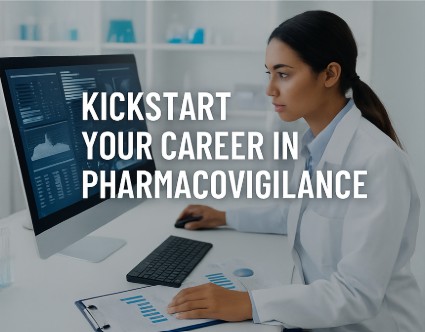Pharmacovigilance (PV) is the science and activities relating to the detection, assessment, understanding, and prevention of adverse effects or any other drug-related problems. With the rise in drug development and regulatory requirements, careers in pharmacovigilance are gaining immense popularity in India and globally.

What is Pharmacovigilance?
Pharmacovigilance involves monitoring the safety of medicines once they are released into the market (Post marketing surveillance). It includes collecting and analyzing data related to adverse drug reactions (ADRs), ensuring drug safety, and reporting to regulatory authorities like the CDSCO (India), EMA (Europe), or US FDA.
Why Choose a Career in Pharmacovigilance?
- Increasing demand for drug safety professionals in pharmaceutical companies, CROs, regulatory agencies, and IT healthcare companies.
- Opportunities for both science graduates and postgraduates.
- Global career scope with options for remote work and international projects.
- Clear career path with continuous learning. opportunities
Contribution to public health and patient safety.
Eligibility: Who Can Apply?
You are eligible for entry-level roles if you have a degree in:
- B.Pharm / M.Pharm.
- B.Sc / M.Sc in Life Sciences (Biotech, Microbiology, Zoology, etc.).
- MBBS / BDS / BHMS / BAMS.
- Nursing (B.Sc Nursing).
Skills You Need
1. Medical & Scientific Knowledge
You must understand drug mechanisms, disease states, and clinical terminology to accurately assess adverse events.
How to Develop – Read standard pharmacology and pathophysiology textbooks – K.D Tripathi (https://amzn.to/42XBq9C).
2. The key global and local pharmacovigilance guidelines you should master in depth—
ICH E2B(R3): Electronic Transmission of ICSRs – Standardizes data elements and format for Individual Case Safety Reports (ICSRs) exchanged between industry and regulators.
ICH E2A: Clinical Safety Data Management—Definitions and Standards for Expedited Reporting – Lays out which adverse events require “expedited” (rapid) reporting and the timelines for submission.
ICH E2C(R2): Periodic Benefit‑Risk Evaluation Report (PBRER)- Framework for creating aggregate safety reports (formerly PSURs).
ICH E2D: Post-Approval Safety Data Management—Definitions and Standards for Expedited Reporting- Updates E2A, covers signals and post‑approval safety data management.
ICH E2E: Pharmacovigilance Planning – Outlines the creation of a Pharmacovigilance Plan (PVP) for new products.
EMA GVP Modules (European Union)- The Good Pharmacovigilance Practices consist of Modules I–X
| Module | Focus |
|---|---|
| I | Pharmacovigilance Systems and Quality Systems |
| II | Pharmacovigilance Inspectors’ Guide |
| III | PV Quality System |
| IV | Signal Management |
| V | Risk Management System |
| VI | PSURs |
| VII | Periodic Safety Update Reports for Vaccines |
| VIII | Post‑Authorization Safety Studies |
| IX | PSURs: Public Disclosure |
| X | Additional Monitoring |
CDSCO Guidelines (India) – India’s Central Drugs Standard Control Organization requirements for safety reporting.
Why It Matters: Local requirements for Indian clinical trial reporting and post‑marketing vigilance.
What to Master:
- SAE reporting timelines in clinical trials (24 hours initial, 14 days follow‑up).
- Periodic Safety Update Reports (PSUR) submission schedules.
- Local forms (e.g., SAE FORM 2).
How to Start Your Career in Pharmacovigilance ?
Take Short-Term Certifications
Enroll in PV-specific courses from reputed institutes like:
- ICRI
- Cliniminds
- TechnoBridge
- Medvarsity
- Coursera / Udemy (for international exposure).
- Many freshers today also use LinkedIn and YouTube to learn the basics of PV.
Gain Hands-On Software Skills
Get trained on Argus, ArisG, or VigiFlow platforms to stand out.
Apply for Internships or Entry-Level Jobs
Start as a Drug Safety Associate, where you’ll learn case processing and database handling. Companies to look for:
TCS
Cognizant
IQVIA
Parexel
Accenture
Novartis
Syneos Health
Career Growth Path in PV
Drug Safety Associate (0–2 years)
PV Officer / Case Processor (2–4 years)
Senior Drug Safety Associate / Medical Reviewer (4–6 years)
Team Lead / Manager – PV (6–10 years)
Head of Pharmacovigilance / QPPV (10+ years)

Pingback: Unlock Your Career in Drug Safety: IPC’s 33rd Pharmacovigilance Skill Program 2025| Application Details & Benefits - Pharma Affairs Hub